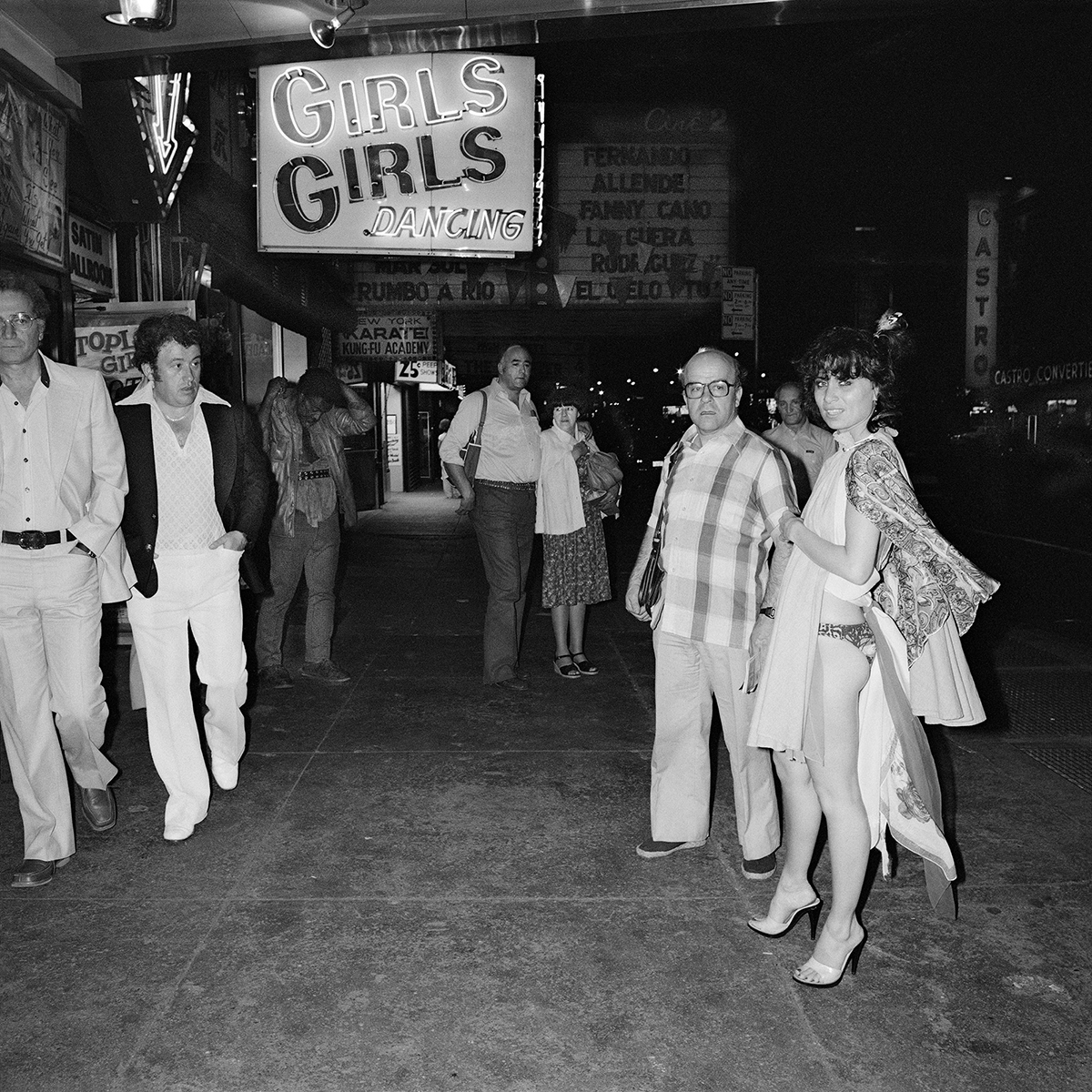Heady nights working in '70s New York go-go bars
- Text by Miss Rosen
- Photography by Meryl Meisler / ClampArt

In spring 1978, photographer Meryl Meisler accompanied her friend Judi Jupiter to an interview to work the bar at the Playmate, a new go-go bar opening on 49th Street and Broadway in New York.
“It was a topless-bottomless bar,” Meisler remembers. “There was disco music playing and girls were dancing on stage. It was fascinating. I asked if I could get a job there as a hostess, and was hired.”
During the late 1970s, Meisler led a double life. By day she worked as a CETA photographer documenting Jewish New York for the American Jewish Congress, exploring her heritage. By night, she was partying at nightclubs like Studio 54 and working at the Playmate, where she soon began making photographs, a selection of which have been published in Purgatory & Paradise SASSY ‘70s Suburbia & The City (Bizarre).
Meisler was required to wear a bathing suit or leotard, stockings, high heels, and makeup, and as hostess, she’d greet customers at the door, seating them by the stage, and serving them $4 “near-beers,” as the bar didn’t have a liquor license. She received a dollar tip for every drink, plus a $10 tip whenever she brought customers to the back rooms for private time with dancers and a $40 bottle of “champagne” (Martinelli’s sparkling cider).
“From time to time, customers would want to spend time with me in the back room,” Meisler says. “I would talk to them and draw them in a little sketchbook I carried. Nobody ever asked for their money back but I never had repeat customers.”

Byron Gives Judi Jupiters Flowers and Lets Smoke out his Nostrils NY, 1978
That December, Meisler and Jupiter left the Playmate and started working at Winks, another midtown go-go bar. After work, they’d go out with all the dancers to the Brasserie, an all-night coffee shop, to catch up over French onion soup.
“One of the women supported herself through medical school, another was buying a house. There was a big range of people. Some had drug problems, some had boyfriend problems, some were supporting kids and other family members. You couldn’t pigeonhole anyone.”
In July 1979, Meisler moved on to a third bar, Magic Carpet, which was painted red and featured a “Sultan’s Chambers”, a massive fish tank, and a swinger’s club upstairs.
That September, Meisler began working as a schoolteacher for the New York City Department of Education. “I hadn’t gotten my paycheck yet, so I continued working on the weekends at Magic Carpet. By November, my money came in, but it wasn’t a lot, so I kept on working in the clubs.”
“By early 1980, I stopped because I knew it was not appropriate for a schoolteacher to waitress at go-go clubs,” Meisler says.
The bars were also getting raided, and people started getting arrested by undercover police. “There were signs that said ‘don’t talk about money’, because it could be construed as prostitution – some people were getting higher tips that way,” remembers Meisler. “When Tina Turner sang ‘Private Dancer,’ I understood that.”

Self-Portrait Playmate Hostess NY, 1978

Playmate Hostesses Dressing NY, 1978

Judi Jupiter, Playmate Bartender NY, 1978

BURLESK GIRLS GIRLS GIRLS Byron, Judi Jupiter and friends NY, 1978

Poochie Wears her Shell Belt to Dance at The Magic Carpet NY, 1979

Girls, Girls, Girls, Dancing with Judi Jupiter in Times Square NY, 1978
Discover more of Meryl Meisler’s work here.
Follow Miss Rosen on Twitter.
Enjoyed this article? Like Huck on Facebook or follow us on Twitter.
You might like

“Humanity’s big threat is our disconnect from nature”: Craig Richards and Chris Levine in conversation
Lighting up — With Houghton Festival collaborating with artist Chris Levine in its most recent edition, we sat down with the light artist and the festival’s creative director Craig Richards to chat about their new installations, and the role of art and music in tumultuous times.
Written by: Isaac Muk

Three heart wrenching poems from Gaza
Writings that narrate — With Gaza’s population facing starvation, we are handing over our website to Yahya Alhamarna, a displaced poet and student in Gaza, who shares some of his recent poetry, and explains why writing is so important to him.
Written by: Yahya Alhamarna

Throwback portraits of the UK’s first punks
Punks 1978-1980 — While working as a photographer in the army, Wayne “Spike” Large would moonlight as a punk on the weekends. His new photobook revisits the characters that he captured from the genre’s heyday.
Written by: Miss Rosen

Will internet age verification actually work?
VPN Summer — With the Online Safety Act coming into force over the weekend, the UK woke up to find pornography, but also any content deemed “harmful” hidden behind an ID wall. But young people are far too tech savvy to be deterred, explains newsletter columnist Emma Garland, who also warns of the dangers of mass data harvesting.
Written by: Emma Garland

Love and rage at the record shattering London Trans+ Pride 2025
Dismantle the cis-tem — With over 100,000 attendees, the Saturday march was the largest trans pride event ever in world history. Cheer Up Luv’s Eliza Hatch captured the action, and recounts its powerful energy.
Written by: Eliza Hatch / @cheerupluv

New documentary revisits NYC’s ’90s skateboarding golden age via the lens of Supreme
Empire Skate — The 30 for 30 documentary premiered in June, exploring how the brand evolved from a Lafayette skate shop into a global streetwear giant.
Written by: Isaac Muk

